Storage bridges come in many varieties within the internal and external market segments. On the external side, they usually have one or more downstream SATA ports. The most popular uplink port is some sort of USB connection. Within the USB storage bridge market, device vendors have multiple opportunities to tune their product design for specific use-cases. USB 3.1 Gen 2 has enabled bus-powered external storage bridges that can bring out the full performance of the SATA device used at the downstream end.
Today’s review will take a look at the Axtremex Micro SSD Gen2 DIY edition. The device is a sleek mSATA SSD enclosure with a USB 3.1 Gen 2 Type-C interface. Axtremex sells multiple variants – both in terms of color and capacity. Models with the SSD included have a Samsung 850 EVO mSATA SSD inside them. Our review is from a storage bridge viewpoint, and we took up the DIY diskless option. The device is currently available on Amazon UK for GBP 50. Axtremex does ship to North America when ordered direct from their site (GBP 41.66 + shipping). We will address the value proposition aspect in the final section, but, before that, let us take a look at the package contents and the PCB itself.
The Axtremex Micro SSD Gen 2 case is made of a zinc alloy and feels more solid in hand compared to aluminum / plastic enclosures. The package also includes a pouch with two compartments (one inside the other). One can be used for the main unit, while the other can be used for storing the cables. This ensures that the drawback associated with a non-integrated cable is addressed and the possibility of misplacing the cable is minimized. Two cables (Type-C to Type-A and Type-C to Type-C) are included to enable connecting to a wide variety of host systems. They are relatively short when compared to other storage bridges that we have evaluated before – However, thanks the compact size of the unit, it feels more like a USB flash drive with an extension cable.
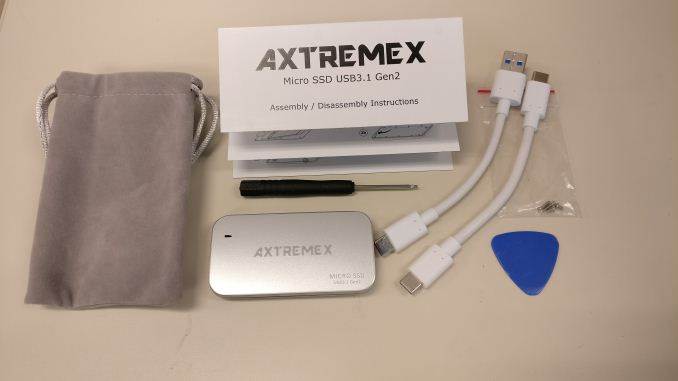
Other than the main components, we have the necessary hardware for the DIY install and a guide for assembly / disassembly. Two pairs of Torx screws as well as a Torx screwdriver are included. One pair is used to secure the mSATA SSD internally, while the other pair ensures that the two parts of the case and the mSATA SSD are all connected together. A plastic triangle opening tool is also present to help pry apart the two side of the case (since the case includes small tabs inside that prevent the two parts from just falling apart after the screws are removed). The gallery below shows more pictures of the case as well as the package contents.
The PCB itself shows that the device is powered by the ASMedia ASM1351 SATA III to USB 3.1 Gen 2 bridge chip. The ASMedia ASM1542 handles the Type-C switching duties. This internal configuration is the same as that of the StarTech.com S251BU31C3CB 2.5″ drive enclosure we reviewed back in September 2016. (except for the obvious fact that we are looking at a mSATA downstream port instead of a full-fledged SATA one).
Consumers need to keep the following aspects in mind for external storage devices / enclosures with a USB interface:
- Support for UASP (USB-attached SCSI protocol) for better performance (reduced protocol overhead and support for SATA Native Command Queueing (NCQ))
- Support for TRIM to ensure SSDs in the external enclosure can operate optimally in the long run
- Support for S.M.A.R.T passthrough to enable monitoring of the internal SATA device by the host OS
The table below presents the detailed specifications and miscellaneous aspects of the units and how they compare.
| Comparative Storage Bridges Configurations | ||
| Aspect | ||
| Downstream Port | 1x SATA III (mSATA) | 1x SATA III |
| Upstream Port | USB 3.1 Gen 2 Type-C | USB 3.0 Micro-B |
| Bridge Chip | ASMedia ASM1351 | JMicron JMS578 |
| Power | Bus Powered | Bus Powered |
| Use Case | mSATA SSD Enclosure DIY high-performance, compact, and sturdy portable SSD with a USB flash drive-like form-factor |
Tool-free 2.5″ HDD/SSD Enclosure (up to 9.5 mm height) |
| Physical Dimensions | 73 mm x 38 mm x 9.5 mm | 130 mm x 82 mm x 14 mm |
| Weight (diskless) | 60 grams (with Type-C to Type-C cable) | 87 grams (with cable) |
| Cable | 12.7 cm USB 3.1 Gen 2 Type-C to Type-C 11.4 cm USB 3.1 Gen 2 Type-C to Type-A |
30 cm USB 3.0 Micro-B to USB 3.0 Type-A |
| S.M.A.R.T Passthrough | Yes | Yes |
| UASP Support | Yes | Yes |
| TRIM Passthrough | Yes | Yes |
| Price | GBP 50 | USD 15 |
| Review Link | Axtremex Micro SSD Gen2 Review | Inateck FE2010 Review |
Our evaluation routine for storage bridges borrows heavily from the testing methodology for direct-attached storage devices. The testbed hardware is reused. CrystalDiskMark is used for a quick overview, as it helps determine availability of UASP support and provides some performance numbers under ideal scenarios. Real-world performance testing is done with our custom test suite involving robocopy bencharks and PCMark 8’s storage bench. The Crucial MX200 has usually been used for our storage bridge tests. However, we were unable to source the mSATA version of the same. Therefore, a Samsung 840 EVO mSATA 1TB SSD was used for the performance benchmarks below. Note that a direct comparison with other configurations using the Crucial MX200 is not quite fair, but, given similar SSDs, we should expect the performance of the Axtremex Micro SSD Gen2 to be similar to the StarTech.com S251BU31C3CB mentioned earlier.
Performance Benchmarks
CrystalDiskMark uses four different access traces for reads and writes over a configurable region size. Two of the traces are sequential accesses, while two are 4K rando accesses. Internally, CrystalDiskMark uses the Microsoft DiskSpd storage testing tool. The ‘Seq Q32T1’ sequential traces use 128K block size with a queue depth of 32 from a single thread, while the ‘4K Q32T1’ ones do random 4K accesses with the same queue and thread configurations. The plain ‘Seq’ traces use a 1MiB block size. The plain ‘4K’ ones are similar to the ‘4K Q32T1’ except that only a single queue and single thread are used.
Comparing the ‘4K Q32T1’ and ‘4K’ numbers can quickly tell us whether the storage device supports NCQ (native command queuing) / UASP (USB-attached SCSI protocol). If the numbers for the two access traces are in the same ballpark, NCQ / UASP is not supported. This assumes that the host port / drivers on the PC support UASP. We can see that the Axtremex Micro SSD Gen2 supports NCQ / UASP.
| Storage Bridge Benchmarks – CrystalDiskMark | ||
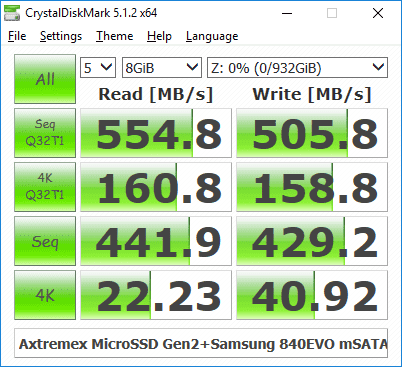 |
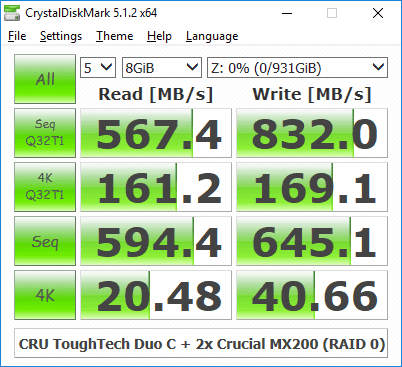 |
|
Moving on to the real-world benchmarks, we first look at the results from our custom robocopy test. In this test, we transfer three folders with the following characteristics.
- Photos: 15.6 GB collection of 4320 photos (RAW as well as JPEGs) in 61 sub-folders
- Videos: 16.1 GB collection of 244 videos (MP4 as well as MOVs) in 6 sub-folders
- BR: 10.7 GB Blu-ray folder structure of the IDT Benchmark Blu-ray (the same that we use in our robocopy tests for NAS systems)
The test starts off with the Photos folder in a RAM drive in the testbed. robocopy is used with default arguments to mirror it onto the storage drive under test. The content on the RAM drive is then deleted. robocopy is again used to transfer the content, but, from the storage drive under test to the RAM drive. The first segment gives the write speed, while the second one gives the read speed for the storage device. The segments end with the purge of the contents from the storage device. This process is repeated thrice and the average of all the runs is recorded as the performance number. The same procedure is adopted for the Videos and the BR folders. Readers interested in looking at all the graphs in one shot can choose the ‘Expand All’ option in the dropdown menu.
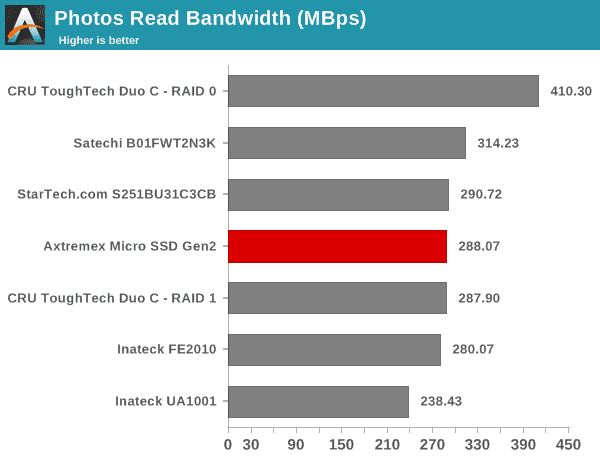
High-performance external storage devices can also be used for editing multimedia files directly off the unit. They can also be used as OS-to-go boot drives. Evaluation of this aspect is done using PCMark 8’s storage bench. The storage workload involves games as well as multimedia editing applications. The command line version allows us to cherry-pick storage traces to run on a target drive. We chose the following traces.
- Adobe Photoshop (Light)
- Adobe Photoshop (Heavy)
- Adobe After Effects
- Adobe Illustrator
Usually, PC Mark 8 reports time to complete the trace, but the detailed log report has the read and write bandwidth figures which we present in our performance tables. Note that the bandwidth number reported in the results don’t involve idle time compression. Results might appear low, but that is part of the workload characteristic. Note that the same CPU is being used for all configurations. Therefore, comparing the numbers for each trace should be possible across different DAS units. Readers interested in looking at all the graphs in one shot can choose the ‘Expand All’ option in the dropdown menu.
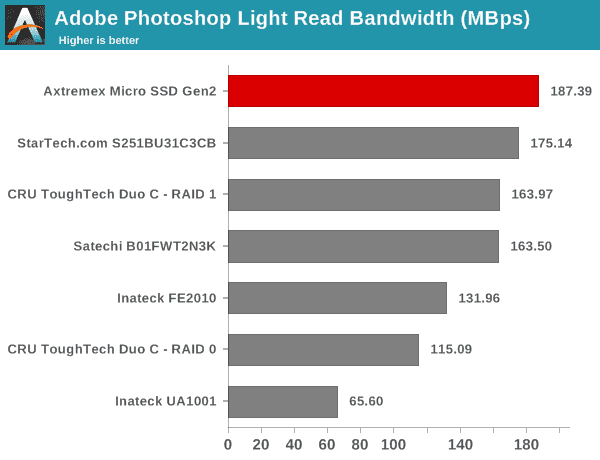
Thermal Aspects and Power Consumption
The thermal design of external storage enclosures has now come into focus, as high-speed SSDs and interfaces such as USB 3.1 Gen 2 can easily drive up temperatures. This aspect is an important one, as the last thing that users want to see when copying over, say, 100 GB of data to the drive inside the enclosure, is the transfer rate going to USB 2.0 speeds. In order to identify the effectiveness with which the enclosure can take away heat from the internal drive, we instrumented our robocopy DAS benchmark suite to record various parameters while the robocopy process took place in the background. Internal temperatures can only be gathered for enclosures that support S.M.A.R.T passthrough. Readers can…











